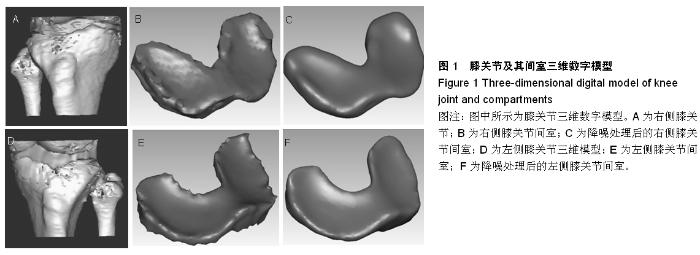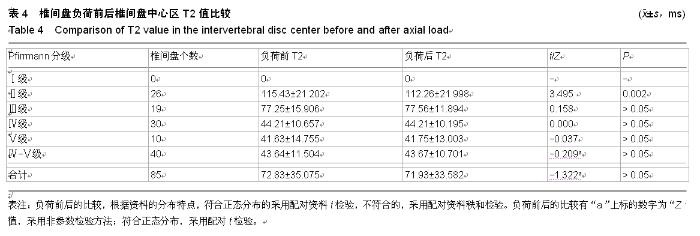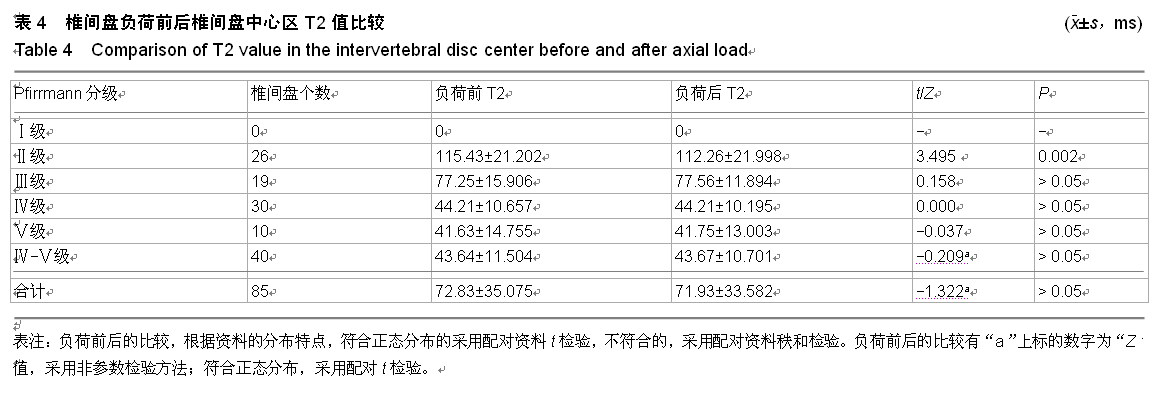| [1] 李永,陈建宇,蔡兆熙,等.腰椎间盘早期退变定量MRI研究的新进展[J].国际医学放射学杂志, 2014,37(6): 560-563.
[2] Ludescher B, Effelsberg J, Martirosian P, et al. T2- and diffusion-maps reveal diurnal changes of intervertebral disc composition: an in vivo MRI study at 1.5 Tesla. J Magn Reson Imaging. 2008;28(1):252-257.
[3] 马晓晖,张伟,高宇,等. 3.0TMRI弥散加权成像评价腰椎间盘退变原因的价值[J].中国组织工程研究, 2014,18(17):2734-2739.
[4] 蒋新华,陈建宇,蔡兆熙,等.正常人椎间盘MRI弥散张量成像AOC值、FA值与年龄和解剖部位的相关性研究[J].中国CT和MRI杂志, 2009, 7(6): 1-5.
[5] 张娅,陈建宇,蒋新华,等. MRI表观弥散系数与腰椎间盘退变分级的相关性[J].中国医学影像技术,2011,27(6):1264-1267.
[6] Antoniou J, Epure LM, Michalek AJ, et al. Analysis of quantitative magnetic resonance imaging and biomechanical parameters on human discs with different grades of degeneration. J Magn Reson Imaging. 2013;38(6): 1402- 1414.
[7] Dardzinski BJ, Laor T, Schmithorst VJ, et al. Mapping T2 relaxation time in the pediatric knee: feasibility with a clinical 1.5-T MR imaging system. Radiology. 2002;225(1): 233-239.
[8] Detiger SE, Holewijn RM, Hoogendoorn RJ, et al. MRI T2* mapping correlates with biochemistry and histology in intervertebral disc degeneration in a large animal model. Eur Spine J. 2014.
[9] Sun W, Zhang K, Zhao CQ, et al.Quantitative T2 mapping to characterize the process of intervertebral disc degeneration in a rabbit model. BMC Musculoskelet Disord. 2013;14: 357.
[10] 刘珍珍,陈建宇,蔡兆熙,等.腰椎间盘退变MRI:T1rho值与Pfirrmann分级及T2值的相关性[J].中国医学影像技术, 2014, 30(2):260-264.
[11] 张斌青,张敏,刘玉珂,等.负重位MRI在腰椎退行性疾病诊断中的价值[J].中医正骨,2014,26(4):33-35.
[12] 蔡兆熙,陈建宇,蒋新华,等.轴向负荷对腰椎间盘MR扩散特点的影响[J].中华放射学杂志,2010,44(8):837-840.
[13] 刘庆余,陈建宇,梁碧玲.腰椎轴向负荷mri检查的临床应用[J].中山大学学报:医学科学版,2007,28(3): 327-331.
[14] 刘庆余,陈建宇,沈君,等.腰椎轴向负荷MRI对腰椎退行性疾病诊断的影响[J].中华放射学杂志,2008,42(3):253-257.
[15] 刘庆余,梁碧玲,陈建宇.腰椎轴向负荷msct检查对腰椎间孔的影响[J].中国医学影像技术,2007,23(9):1382-1385.
[16] 刘庆余,梁碧玲,陈建宇,腰椎轴向负荷msct检查对椎管的影响[J]. 临床放射学杂志, 2008,27(5):647-651.
[17] 刘庆余,梁碧玲,陈建宇,等.轴向负荷对腰椎硬膜囊的影响[J].中国组织工程研究与临床康复, 2008,12(30):5819-5823.
[18] Kealey SM, Aho T, Delong D, et al. Assessment of apparent diffusion coefficient in normal and degenerated intervertebral lumbar disks: initial experience. Radiology. 2005;235(2): 569-574.
[19] Pfirrmann CW, Metzdorf A, Zanetti M, et al. Magnetic resonance classification of lumbar intervertebral disc degeneration. Spine (Phila Pa 1976). 2001;26(17): 1873-1878.
[20] Urban JP, Smith S, Fairbank JC. Nutrition of the intervertebral disc. Spine. 2004; 29(23): 2700-2709.
[21] Hannila I, Raina SS, Tervonen O,et al. Topographical variation of T2 relaxation time in the young adult knee cartilage at 1.5 T. Osteoarthritis Cartilage. 2009;17(12): 1570-1575.
[22] Marinelli NL, Haughton VM, Munoz A, et al. T2 relaxation times of intervertebral disc tissue correlated with water content and proteoglycan content. Spine (Phila Pa 1976). 2009;34(5): 520-524.
[23] 沈思,王昊,汪飞,等. DWI和DTI对腰椎间盘早期退变的诊断价值[J].暨南大学学报:自然科学与医学版,2012,33(4):409-413.
[24] 俎金燕,王晨光,贾宁阳,等.椎间盘退变的磁共振弥散加权成像研究[J].脊柱外科杂志, 2012,10(6):356-359.
[25] 陈耀康,杨汉丰,杜勇,等.正常成人腰椎间盘ADC值的初步测定[J].中国CT和MRI杂志, 2013,11(4):111-113,120.
[26] 邓绍强,杜勇,杨汉丰,等.弥散加权ADC值定量评价髓核蛋白多糖含量的研究[J].中国临床医学影像杂志,2013,24(9):650-653.
[27] 李丽,周治国,王敏,等. ADC值评估腰椎间盘退变程度的研究[J]. 放射学实践,2013,28(12):1279-1282.
[28] 田欣,朱芳华,耿左军,等.椎间盘退变 Pfirrmann分级的髓核磁共振扩散张量成像参数值研究[J].河北医药, 2013,35(22): 3369- 3371.
[29] 赵建,郭智萍,王林峰,等.腰痛患者腰椎3.0T MR弥散加权成像腰椎间盘表观弥散系数与椎间盘退变分级的相关性[J].中国脊柱脊髓杂志,2013,23(12):1074-1078.
[30] 俎金燕,王晨光,贾宁阳,等.腰椎间盘退行性变的磁共振弥散加权成像研究[J].实用放射学杂志,2013, 29(4):611-614,634.
[31] Zhang W, Ma X, Wang Y, et al. Assessment of apparent diffusion coefficient in lumbar intervertebral disc degeneration. Eur Spine J. 2014;23(9):1830-1836.
[32] Yu HJ, Bahri S, Gardner V, et al. In vivo quantification of lumbar disc degeneration: assessment of ADC value using a degenerative scoring system based on Pfirrmann framework. Eur Spine J. 2014.
[33] 郭智萍,史大鹏,张旭静,等. 3.0T MRI功能成像诊断腰椎间盘退行性病变价值[J].中华实用诊断与治疗杂志,2014, 28(7): 709- 710.
[34] 葛涌钱,周学军,包雪平,等. 3.0T MR IDEAL和T2 mapping成像在腰椎间盘退变中的应用[J].中国CT和MRI杂志, 2015,13(2): 81-83,87.
[35] Drew SC, Silva P, Crozier S, et al. A diffusion and T2 relaxation MRI study of the ovine lumbar intervertebral disc under compression in vitro. Phys Med Biol. 2004;49(16): 3585-3592.
[36] Paajanen H, Lehto I, Alanen A, et al. Diurnal fluid changes of lumbar discs measured indirectly by magnetic resonance imaging. J Orthop Res. 1994;12(4): 509-514.
[37] Kerttula L, Kurunlahti M, Jauhiainen J, et al. Apparent diffusion coefficients and T2 relaxation time measurements to evaluate disc degeneration. A quantitative MR study of young patients with previous vertebral fracture. Acta Radiol. 2001; 42(6): 585-591.
[38] Roberts N, Hogg D, Whitehouse GH, et al. Quantitative analysis of diurnal variation in volume and water content of lumbar intervertebral discs. Clin Anat. 1998; 11(1): 1-8.
[39] Zhu T, Ai T, Zhang W, et al. Segmental quantitative MR imaging analysis of diurnal variation of water content in the lumbar intervertebral discs. Korean J Radiol. 2015;16(1): 139-145.
[40] 祝婷婷,李涛,张淯淞,等.正常腰椎间盘MR弥散的早晚变化[J]. 临床放射学杂志,2014,33(10):1567-1570. |







